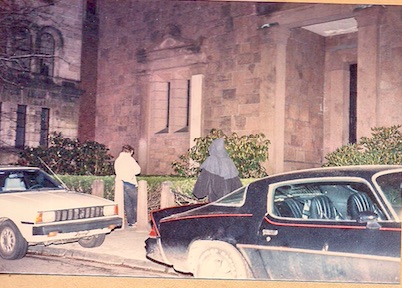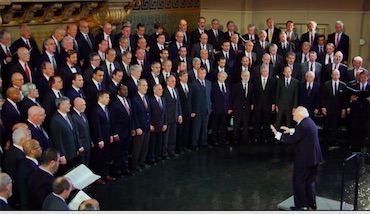Stories
Midterm Report on Culture of Peace - 2005
Youth Report on Culture of Peace - 2006
A trilogy of books for a new strategy
Final Report on Culture of Peace - 2010
Struggling with the United Nations
* * *
The Culture of Peace News Network continued
Missions for the Culture of Peace
Travels with Lindsay in the USA
Vacations with Lindsay in the Caribbean
In writing my book, History of the Culture of War, I could draw on many experiences of contacts with the war culture. Let me begin with a photo I took on "tap-night" back in 1986 in front of the windowless headquarters of Skull and Bones at Yale (called "the tomb").

New inductee entering Skull and Bones on "tap-night."
Notice that the Skull and Bones member who will leading the blind-folded inductee into "the tomb" is dressed in the hood of the Inquisition and the Ku Klux Klan. In fact, Skull and Bones goes back as a Yale secret society to the early 19th century when the average Yalee came from the American South where it was the Ku Klux Klan than ensured the dominance of their parents who were slave-owners.
During the Second World War, many of the top agents of the OSS, the predecessor of the CIA were Yale graduates who had been inducted into Skull and Bones. This was convenient because they all knew each other and could be sure that they had not been infiltrated as spies. In fact they recruited each other into the OSS much as they had recruited each other into Skull and Bones a few years earlier. After World War II, the OSS was replaced by the CIA and the tradition was continued. Many of the top leadership of the CIA were Skull and Bones, most prominently President George Bush who had been the head of the CIA before becoming President.
Skull and Bones recruited from the undergraduate body of Yale. Although I cam to Yale as a graduate student, I got to know the CIA through my membership in the Yale Russian Chorus. I didn't go with them to the Soviet Union (where I suppose they attracted and recruited dissidents), but I did go to their annual alumni concert in Washington which was traditionally hosted by their CIA members and alumni. I stayed in the home of an agent and at breakfast his mother, learning that I was a psychology student, asked for my advice because her boy was bringing home boyfriends instead of girlfriends!

An alumni concert of the Yale Russian Chorus.
My membership in the Yale Russian Chorus preceded my political radicalization which came a few years later during the Vietnam War. Hence, I was simply amused by the drunken parties of the Chorus where they sang songs with virulent anti-communist lyrics.
By the time I became political and started going to the Soviet Union, the budget of the CIA was enormous. We didn't know how much at the time, but in recent years, the whistle-blower Edward Snowden has revealed a budget of over $50 billion a year. If we assume $200,000 a year for each employee, that means 250,000 agents and "assets."
With so many agents and assets running around, it is not surprising that I should have encountered them more than a few times in my life.
One of the most spectacular was the professor from a small mid-western college in the United States who had a Fulbright fellowship at the same time as me to Soviet Georgia in 1980. One evening after drinking too much, he confided to me that his task was running guns into Chechnya in order to weaken "the enemy," i.e. the Soviet Union. This was many years before Chechnya exploded.
On more than one occasion I was accused of being a double-agent of the CIA and KGB. When I was a Fulbright fellow, the US embassy in Moscow insisted that I deliver a package to their people in Georgia. I assume that they knew I was being followed by the KGB and that it would label me as an American agent. Later, at UNESCO, where we assumed that many of the American officials were from the CIA, word got out that I was pro-Soviet. As a result, colleagues told me it was assumed I was a double-agent. I laughed and told them to go ahead and propagate the rumor, so that no one would dare to bother me!
Always curious about these matters, I made it a point to meet and speak with those I presumed to be agents. One was an American representing the State Department at the high-level meetings about Plan Colombia that took place in Spain while I was at UNESCO. As the UNESCO representative, I made it a point to have lunch with him. We spoke about Skull and Bones, in which he was a member, and about his name which was "Mack" - yes a descendent of the great baseball manager Connie Mack.
The essence of the CIA, like its equivalents in other countries, is secrecy (one of the key akpects of the culture of war). Once when back in the US after a Russian journey I met another runner by chance running along the great Nauset Beach of Cape Cod. Somehow, as we ran and talked the subject of Russia arose and I said I just came from there. He seemed interested so I asked him (in Russian) if he could speak Russian. "Nice weather, isn't it?" he replied. In other words, he was a CIA agent and assumed that i might be one as well. If he spoke further about political subjects, I might report him as a "leak."
The secrecy of the CIA makes it especially ineffective and inept. It was said that when a group of agents kidnapped President Aristide and sent him out of Haiti, they were acting against another group of agents who were protecting him. But since CIA operations and operators are top secret, there was no way they could know about each other! One wonders if agents have not sometimes killed other agents in the line of duty as a result of such ignorance!
It seems I was never important enough politically to be a target of the CIA. On the other hand, as I have recounted elsewhere, when the People's Peace Appeal became threatening during the 1980s, the CIA (or was it the FBI?) sent young female agents to seduce and entrap our director.
The worst case was a man who told me that he was the one who met the CIA planes at the Arkansas airport used to run guns to the contras and return with cocaine. He was the courier who took the cocaine to the Mafia and returned with the money for the coffers of the CIA. He told me that he could not tell me his real name. He had assumed a new life because he would be killed if they knew who and where he was. In the course of our conversation he told me enough to convince me of his honesty, as well as his reasonable fears.
And, of course, the most important victim was President Kennedy. ZR Rifle, a book that I bought in Havana tells how the Mafia, CIA and anti-Castro Cubans were involved in the assassination. The information came from the author's interviews with the retired head of Cuban intelligence, who knew the details because they had infiltrated the anti-Castro Cubans who were involved. The CIA agent directly involved was David Phillips, and ultimately the person responsible was Richard Helms, the "brain of the CIA." Typical of CIA secrecy, it seems that the CIA Director at the time, John McCone, was not informed.
In writing in the History of the Culture of War about the CIA's role in running guns and drugs, I dared not give all the details that I have known, but referred readers to the Internet to seek out more information.
 |
Stages
1986-1992
Fall of Soviet Empire
1992-1997
UNESCO Culture of Peace Programme
1997-2001
UN Intl Year for Culture of Peace